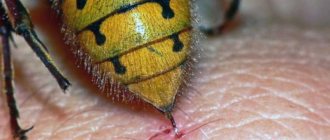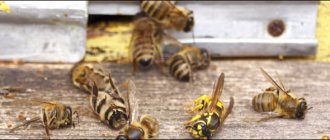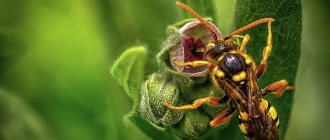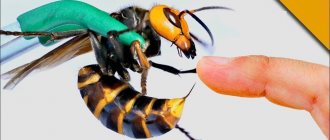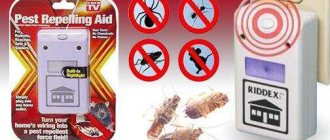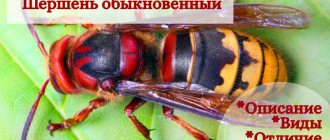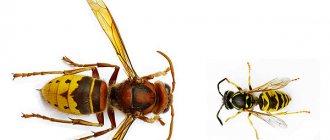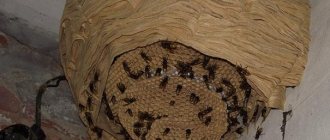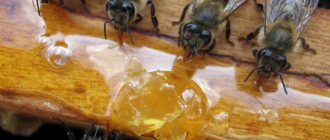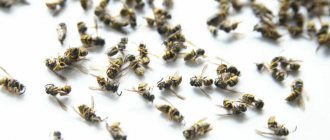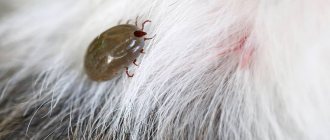There is an opinion that hornets are waging a real war of extermination against bees. Many videos circulating on the Internet, and even professionally produced scientific and educational short films, clearly show how one hornet against hundreds of bees manages not only to survive, but also to destroy numerous rivals.
However, only a viewer far from entomology might think that hornets are carrying out a unique and specifically targeted genocide against bees. In reality, everything is much more banal.
It's no secret that hornets are killers of almost any insect. Although it is not entirely correct to label these large wasps “killer” in its well-known sense, because they are just simple hunters, obtaining meat to feed their larvae.
For the constant growth and normal functioning of the colony, workers are forced to continuously find new prey, kill it and bring it to the nest. These insects are simply programmed by nature for this behavior. And it doesn’t matter whether a caterpillar, a bee or even a small frog falls under the powerful jaws of a hornet - a clever hunter will do everything possible to ensure that the prey benefits his family.
On a note
By and large, a hornet is a killer to exactly the same extent as this formidable word can be used to describe, for example, an ant. Everyone knows that every ant constantly brings small caterpillars, beetle larvae and other insects into its home, but no one calls it a killer. Perhaps this is because the hunt of an ant is still not as spectacular and accessible to the observer as, for example, the fight between a praying mantis and a hornet.
A bee hive is an almost ideal food source for a hornet. Firstly, these honey insects gather in large numbers near their nest, so they are easy to catch. Secondly, they are a valuable source of nutrients for predator larvae. And, finally, thirdly, the destruction of the hive gives the opportunity to enjoy honey, and this is especially pleasant for large wasps, because their adults feed mainly on sweet foods.
Thus, the presence of at least one hive in the habitat of winged predators really provides the entire colony with complete, balanced nutrition, and without much difficulty. It is not surprising that hornets kill bees often and in large quantities, although they do not specialize only in hunting them.
Hornets and bees: hunters and prey
The bumblebee, hornet, bee and wasp are representatives of a large order of Hymenoptera insects, which also includes ants and riders. All of them are united by similarities in appearance and some behavioral features.
However, hornets, wasps, bees and bumblebees are, in addition, owners of a poisonous sting.
This is interesting
Some fairly primitive tropical ants are also equipped with a sting, and their bite is much more painful than the sting of an ordinary bee.
The toxins of all poisonous insects of this order are generally quite similar in composition. However, the venom of each specific species has a number of features that determine its effect on the body of the stung.
For example, hornet venom is highly allergenic; it has a stronger effect on the enemy’s nerve receptors than others. But at the same time, bee venom causes more severe poisoning of the body due to the large amount of toxin injected at a time.
As already noted, different types of insects are poisonous in different ways. For example, the common hornet stings, of course, painfully, but its bites are rarely accompanied by serious consequences. But the huge Asian hornet is one of the most dangerous insects on Earth.
In the video you can see in detail how the hornet kills bees - it uses its powerful jaws for this, and not poison at all, as it might seem to an uninformed viewer.
A certain pattern can be noticed in the hornets' hunt for bees - in most cases, predators do not attack single victims collecting nectar. They act more cunningly - they track them down and record the location of the nest, so that they can then return here in larger numbers.
Depending on the type of winged predator, a different number of attackers is required to completely destroy a hive of honey-bearing prey. This rule almost always applies, but there are some nuances here too.
So, for example, if we are talking about European hornets, then theoretically, only a few hundred predatory insects can destroy a hive of 10-15 thousand individuals. However, very rare families of hornets reach such sizes by the end of summer, and therefore in our country these predators prefer to attack single bees, without risking attacking hives. But even in such cases, the damage to apiaries is quite noticeable.
The giant Asian murder hornets, which are almost twice the size of their European relatives, are a completely different matter. Without special methods of protection, bees are absolutely helpless against hornets of this species. Let's take a closer look at these formidable, but no less interesting, predators.
It is also useful to read: Photos of the hornet sting and its features
What are wax bees?
As a rule, wax bees of the Apis cerana species live in the territory of modern China, Japan, Korea and Vietnam. In Russia, these creatures can only be encountered in the deciduous forests of the Primorsky Territory. They are very rare and are even listed in the Red Book. Insects build hives in the hollows of old trees and rock crevices. If bees cannot find a suitable place to live, they settle in abandoned apiaries.
Apis cerana bees are very rare in Russia
Giant hornets and their hunt for bees
One of the determining factors in the superiority of the Asian giant hornet over its smaller relatives is its size. The body length of this largest wasp is more than 5 cm, i.e. almost three times more than the same parameters of a worker bee. With one precise movement of its jaws, a huge attacking predator easily breaks the joint between the head and chest of its prey, after which it becomes paralyzed and can no longer move.
In a minute, such a hornet is capable of killing more than 30 bees, and to destroy a multi-thousand-strong honey-bearing colony, a squad of only 30-40 predators only needs a few hours.
This is interesting
The chitinous cover of the hornet's body is so hard that bees, in defense, can pierce it with their sting only in some places. But even in this case, the attacking insect will not suffer much.
The video usually clearly shows how huge hornets act against bees defending their hive: the predators practically do not use their stings.
Attack of several hornets on a beehive
And since the bee family is such a “tidbit” for the hornets, the latter eagerly search for hives and destroy entire families.
Interestingly, the war between bees and hornets is a process started by humans. Without its influence, such active extermination does not occur in nature.
Bees as a defender: their capabilities and secret weapons
In nature, the species of the Giant Asian hornet and the European honey bee do not overlap with each other: the first lives in Japan and Southeast Asia, the second in Europe and the Middle East.
But Asian bees fight hornets with a very original method, developed during joint evolution: a large number of potential victims stick around the predator, forming a huge ball of their bodies around it - up to 30 cm in diameter. At the same time, insects actively move their wings.
This behavior is explained by the fact that from such muscular work the air inside the ball heats up, and the heat from the movement of the wings is directed to its center, i.e. to the attacking insect. For the giant predator, a temperature of 46-47°C is fatal, so after just an hour of being in such a ball, it dies, destroying only a few owners of the nest. The bees themselves are able to normally withstand temperatures up to 50°C, and those of them that did not fall under the jaws of the dying giant wasp survive.
This is interesting
To organize one ball and destroy one hornet you need about 500 bees. A family of 15-20 thousand working individuals is able to withstand an attack by 30-35 hornets, which reliably protects them from these natural enemies.
If we talk about European bees living in the latitudes of our country, it is worth noting that they do not know how to defend themselves in this way. In the wild, local hornets practically do not attack honey hives, and therefore evolutionarily similar defensive behavior has not developed in European bees.
But these insects collect significantly larger amounts of honey, which is why Japanese beekeepers bring and actively try to breed them in the habitats of giant hornets.
As mentioned above, the war between bees and hornets is an artificial phenomenon, provoked entirely by man. Therefore, the attempts of Asian beekeepers rarely end in success - when huge predators find a hive that is unable to defend itself, a real massacre begins. Without the forced relocation of bees to the other side of the continent, this would not have happened.
By the way, this is why most of the videos with hornets attacking bees are filmed in artificial evidence. European bees are not able to reproduce in the natural conditions of Asia, so predatory giant wasps can only attack them in the apiary.
Unusual insects of Vietnam
The scientific publication Science Alert reported on how scientists managed to record the cries of frightened bees. As part of the study, they installed microphones inside hives of Chinese wax bees (Apis cerana). They launched several huge hornets (Vespa soror) towards the insects and saw how the colony would react to them. To obtain more accurate results, they studied bees in three hives at once, located in different parts of the Vietnamese city of Hanoi.
Hornet attack on wax bees
Hornets vs bumblebees: who is stronger when they meet?
The relationship of giant wasps with other insects is similar to their relationship with bees: almost any arthropod that is inferior to this predator in size and strength is its potential victim. Let's identify the most prominent opponents of the Hornets.
It is also useful to read: How to get rid of hornets and wasps: effective methods and safety rules
The hornet and the bumblebee are clear hunter and prey.
A bumblebee is just as defenseless against this predatory insect as a bee, only it takes more effort to kill it. However, it is worth noting that the European hornet is unlikely to attack a bumblebee due to its small size, but the Asian hornet is quite capable of this.
Thus, if the sizes of the rivals are approximately equal, it is impossible to say for sure who is stronger - the bumblebee or the hornet. There is a high probability that when a bumblebee meets a hornet, it will resist.
It is also quite reckless to assert that these insects are enemies. In most cases, they are still neighbors who simply have to tolerate each other. The bumblebee differs from the hornet in being more peaceful, and also in that it is not a predator. However, he is also capable of giving a worthy rebuff to the attacker.
Collisions of these insects in the wild are almost never recorded, and therefore the “hornet vs. bumblebee” video is a rarity. Here is one of the few examples:
Hornet deals with bumblebee
- The hornet and the wasp are a generally similar predator-prey pair.
- Hornet attacks on wasp nests are extremely rare, since wasps are exactly the same predators, and, having gathered in large numbers, they are able to successfully resist attackers.
- The praying mantis against the hornet, unlike the two previous rivals, is practically helpless.
- Powerful legs - the only weapon of the praying mantis against aggressors - are not capable of harming a large wasp. The hornet does not even use poison against such a victim, because to win it only needs to gnaw off the joint in the insect’s neck.
The video shows how the hornet kills the praying mantis:
Giant Asian hornet vs praying mantis
Basic measures to protect the apiary
There are a sufficient number of effective ways to combat these dangerous insects. These include:
- placement of special traps;
- use of chemicals with insecticides;
- turning to specialists for help.
You should find and get rid of wasp nests, which are balls supported on a stem. Nests can be located under sheds, in attics, or in other secluded places. The structures need to be removed at night so that the insects are in the nest and inactive. A plastic bag of appropriate size is selected in advance. The nest is carefully torn off and placed in a bag, the edges of which are tied. After which the pests can be burned or drowned in water.
Integrated control of wasps and hornets is effective in the fall.
Using traps
A common method of exterminating wild insects are special traps, which can be purchased in specialized stores or made independently.
You might consider making an effective trap. For this you will need:
- plastic container with a volume of 1.5 l;
- sweet syrup or other aromatic bait (honey, jam);
- vegetable oil;
- knife.
Using a sharp knife, cut off the top of the container and pour sweet syrup inside. Insert the cut part of the bottle upside down. Place the device in a place where wild insects accumulate. The walls of the container should be lubricated with vegetable oil so that wasps caught inside the trap cannot get out.
Traps will not be able to radically solve the problem of attacks by wasps and hornets, but they will help destroy individual, most intrusive individuals. It is prohibited to use such devices in the vicinity of the apiary. Otherwise, beneficial insects will also fall into the trap.
Poisonous baits
Poisonous bait will help get rid of pests quickly. You can prepare it yourself as follows:
- As a product that attracts the attention of insects, you can take meat cut into pieces or minced meat.
- Prepare in advance any toxic substance that can be purchased at hardware stores.
- Mix the minced meat well with the poison and leave it in a place accessible to wasps.
Knowing the collective behavior of wild insects, one can imagine how quickly the entire colony will be poisoned by a toxic substance. The wasp will carry the poison into the nest and feed it to the queen and larvae.
When using this method, you must ensure that cats, dogs and other animals cannot eat the bait.
Special aerosol against wasp nests
The use of a special aerosol containing insecticides will quickly destroy all insect pests.
The chemical industry offers the following drugs:
- "Medilis-Super". 3rd class of danger. A solution is prepared in the following proportion: per 1 liter of water – 4 g of substance.
- "Masterlak". It is a toxic liquid with long-lasting effects.
- "Karbofos". 3rd class of danger. Sold in powder form. Prepared in the following proportion: 1 liter of water – 10 g of powder.
- "BROSS" from wasps and hornets. 4th hazard class. Produced in the form of a spray.
When using these products, you must observe the following precautions:
- move away from the object as far as possible;
- use protective masks, gloves, and clothing made of thick fabric.
To whom will the hornet yield in battle?
By analogy with previous connections between hornets, we can also identify those who are more likely to be the aggressor in relation to this insect.
The relationship between winged predators and spiders stands apart from all others.
Interestingly, a spider versus a hornet can look like both a victim and a killer at the same time. For example, small spiders that hunt without creating a web - small tarantulas, jumpers, haymakers - often fall into the jaws of a hornet and die. But if the insect itself falls into the web of even a cross spider that is not very large and non-poisonous to humans, then, most likely, it will be eaten.
The video shows how quickly the spider could deal with the hornet in its web:
Spider vs hornet
Hornet vs Tarantula Spider has an average chance of winning. These rivals have approximately the same body size, but the spider’s body, among other things, is equipped with strong venom and very powerful chelicerae. Therefore, in this skirmish the one who bites first will win.
The hornets' closest relatives - large road wasps and wandering ants - can also be formidable rivals.
Despite their physiological adaptation to killing, the hornets themselves often become their victims. This is explained by the fact that wasps have a very powerful poison that is destructive to the hornet, and ants simply take in numbers - they always attack in a group.
One of the most original biological enemies of hornets is a unique fungus that develops in the insect’s brain.
The spores of this fungus enter the hornet's body through the mouth or respiratory tract and germinate in its head. During its development, the mycelium secretes special substances that cause the insect to feel constant thirst.
Willy-nilly, driven by instinct, the hornet looks for a suitable place to drink, and here the developing killer mushroom causes paralysis in the insect. The victim freezes in a completely unexpected position - for example, hanging on a blade of grass.
At the last stage of its life cycle, the parasite releases a fruiting body, thereby spreading new spores in a humid environment favorable for this process. Thus, a predatory insect, by its death, gives life to another, albeit such an ambiguous, living organism. Entomologists often find wasps and hornets with dried fungal bodies protruding from their heads.
Hornets also have enemies among vertebrates.
Bee-eaters - birds that specialize in feeding on bees and wasps - catch the hornet so that it cannot sting them. Afterwards, they smash the insect against a stone and swallow it without harming their health.
Some other insectivorous birds can also feed on hornets in a similar way. But among mammals, the only one that is definitely dangerous for this insect is a person who has learned to destroy not only individual wasps, but also their nests without much difficulty.
However, most often hornets die not from the “hands” of opponents worthy of strength, but from small parasites - mites, nematodes and riders, which cannot be destroyed.
To summarize, it is impossible not to mention the well-known scientific fact: there is nothing useless in living nature. The life cycle of every organism is subject to strict laws; Each organism in nature occupies its own niche and can serve to one degree or another as a predator or prey.
So it is with the hornet: there are objects that it eats, acting as a formidable killer, and there are also those that destroy it, not paying any attention to the full power of this insect’s biological weapons.
Interesting video: bees work together to kill a hornet
The danger of murder hornets
As for the huge hornets of the Vespa soror species, they live in India, Thailand, Vietnam and some other Asian countries. The body length of working individuals can reach 3.5 centimeters, and queens grow up to 4.6 centimeters. As a rule, they build nests in forests, underground. These are very aggressive insects - people have noticed many times that they attack the hives of honey bees and smaller species of hornets. In some cases, they even attack praying mantises and small vertebrates like geckos.
Dimensions of a hornet compared to a human finger
Links to interesting articles, funny memes and much other interesting information can be found on our Telegram channel. Subscribe!
Despite their aggressiveness, hornets are protected in some countries. The fact is that they actively destroy garden pests such as flies and ticks. However, representatives of the Vespa mandarinia species are not particularly useful and sometimes even attack people. Victims of these creatures describe their bites as being struck by a hot nail. Read more about who hornets are and why their widespread distribution around the world is dangerous.
